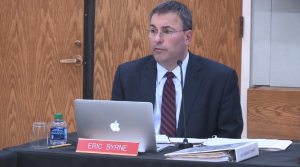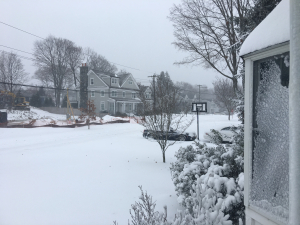Column: Questions @ School Budget by Former BOE Trustee

In a column, former Board of Education Trustee and Ridgewood Drive resident Bob Zahm analyzes over a dozen years of school budgets and asks for answers to three key questions.
By Bob Zahm
Zahm served on the Rye City School District Board of Education from 2004-2010. A computer consultant by trade, Bob earned his BS Computer Engineering at the University of Michigan and an MBA in Accounting from the University of Pittsburgh. He has lived in Rye since 2001 and is a member of Rye Presbyterian. Bob is an active stamp collector and is always available to “talk stamps” or budgets.

The Rye City School District Board of Education recently approved the Superintendent’s proposed 2024/25 school budget without change. The budget increases planned spending by $6.7 million (6.4%) to $110.6 million. As the proposed budget’s growth exceeds the New York State budget-cap, 60% voter approval will be required for it to be passed. Typically, in Rye, it’s not too tough to get the community to support increased schools spending.
I’ve avoided looking closely at RCSD finances since the $80+million bond fiasco of 2019. However, enough time has passed for another look. The size of the increase gives even more cause for reviewing the proposal.
The District has provided me with the historic budget books (proposals) and audited financials from 2011 onwards. Based on this data, I have drawn the following four conclusions:
1. The District consistently overbudgets and underspends, creating ”margin” and adding to reserves.

The total over-budgeting between 2011 and 2023 (the last year for which an audit has been completed) is $49.7 million. This is money that the District may choose to use however it wishes. For example, spending more on facilities enhancements that didn’t fit within the $82 million bond.
2. From its peak in 2016, District enrollment has dropped by 593 students in 2023, with a further drop of 25 students forecast for the new school year.
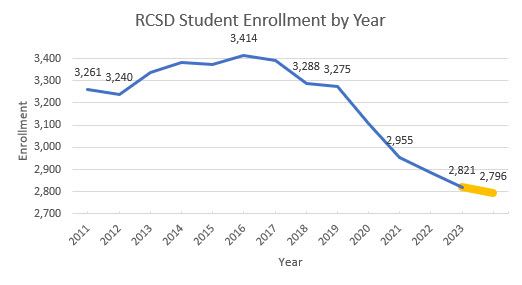
The District’s peak enrollment in 2016 of 3,414 was the culmination of a long trend starting as far back as 1995 when enrollment was 2,148. While a downward trend is probably not a permanent feature for Rye, declines could be significantly larger than the roughly 600 to-date.
3. Proposed District expenditures have grown year after year both with enrollment increases and enrollment decreases.
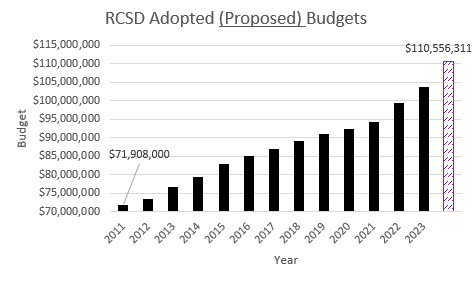
Starting with the peak enrollment year of 2016, when budgeted spending was $85 million (actual, audited spending was $80.2 million), budgets have increased each and every year regardless of enrollment trends.
4. Student-facing staffing has remained relatively unchanged since a step change increase of 17.4 FTEs in the 2017/18 school year. That number is forecast to decrease by 5.5 Full Time Equivalents (FTEs) in the proposed budget. However, the District will still have almost 12 more positions in comparison to staffing levels at peak enrollment.
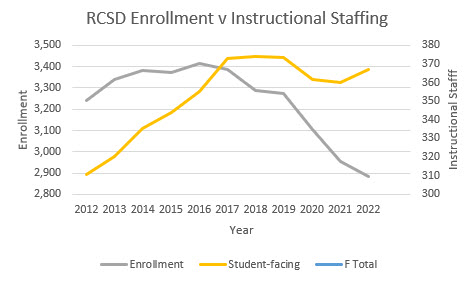
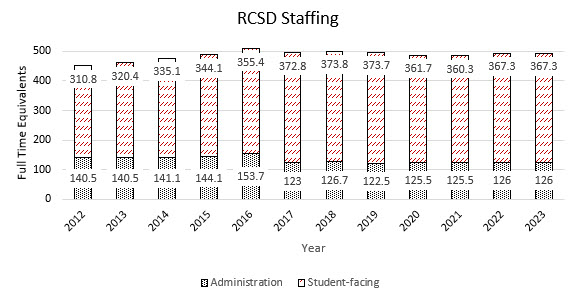
At the same time that student-facing staffing increased, administrative-staffing declined by approximately 20 FTEs. Staffing data is no longer presented by the District showing position by school, but it appears that the drop is due to the reduction of support staff for the central office.
Conclusion
While I have not monitored Board meetings, this data and the associated trends suggest a number of questions that should be posed to the Board of Education and the Superintendent.
- Why should proposed spending continue to rise when historically the District never spends its full budget?
- Why, given an enrollment decrease of almost 18%, has staffing not also decreased and why has spending increased by 30%?
- With reserves totaling almost $19 million, it would seem that something needs to change in the budget and the budgeting process of the Rye schools.
The views in this column belong to the author.
Publisher’s note: On Tuesday, May 21, 2024, the community will be asked to vote on the 2024-2025 school district budget and for Board of Education trustees.


